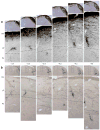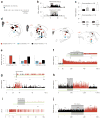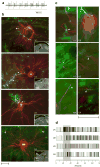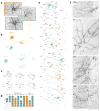A neural mechanism for exacerbation of headache by light
- PMID: 20062053
- PMCID: PMC2818758
- DOI: 10.1038/nn.2475
A neural mechanism for exacerbation of headache by light
Abstract
The perception of migraine headache, which is mediated by nociceptive signals transmitted from the cranial dura mater to the brain, is uniquely exacerbated by exposure to light. We found that exacerbation of migraine headache by light is prevalent among blind individuals who maintain non-image-forming photoregulation in the face of massive rod/cone degeneration. Using single-unit recording and neural tract tracing in the rat, we identified dura-sensitive neurons in the posterior thalamus whose activity was distinctly modulated by light and whose axons projected extensively across layers I-V of somatosensory, visual and associative cortices. The cell bodies and dendrites of such dura/light-sensitive neurons were apposed by axons originating from retinal ganglion cells (RGCs), predominantly from intrinsically photosensitive RGCs, the principle conduit of non-image-forming photoregulation. We propose that photoregulation of migraine headache is exerted by a non-image-forming retinal pathway that modulates the activity of dura-sensitive thalamocortical neurons.
Figures




Comment in
-
Shining a spotlight on headaches.Nat Neurosci. 2010 Feb;13(2):150-1. doi: 10.1038/nn0210-150. Nat Neurosci. 2010. PMID: 20104207 No abstract available.
Similar articles
-
Migraine photophobia originating in cone-driven retinal pathways.Brain. 2016 Jul;139(Pt 7):1971-86. doi: 10.1093/brain/aww119. Epub 2016 May 17. Brain. 2016. PMID: 27190022 Free PMC article.
-
Neurobiology of Photophobia.J Neuroophthalmol. 2019 Mar;39(1):94-102. doi: 10.1097/WNO.0000000000000766. J Neuroophthalmol. 2019. PMID: 30762717 Free PMC article. Review.
-
Shining a spotlight on headaches.Nat Neurosci. 2010 Feb;13(2):150-1. doi: 10.1038/nn0210-150. Nat Neurosci. 2010. PMID: 20104207 No abstract available.
-
Current understanding of photophobia, visual networks and headaches.Cephalalgia. 2019 Nov;39(13):1623-1634. doi: 10.1177/0333102418784750. Epub 2018 Jun 25. Cephalalgia. 2019. PMID: 29940781 Free PMC article. Review.
-
Cortical projections of functionally identified thalamic trigeminovascular neurons: implications for migraine headache and its associated symptoms.J Neurosci. 2011 Oct 5;31(40):14204-17. doi: 10.1523/JNEUROSCI.3285-11.2011. J Neurosci. 2011. PMID: 21976505 Free PMC article.
Cited by
-
Assessing migraine patients with multifocal pupillographic objective perimetry.BMC Neurol. 2021 May 26;21(1):211. doi: 10.1186/s12883-021-02239-z. BMC Neurol. 2021. PMID: 34039302 Free PMC article. Clinical Trial.
-
Atypical resting-state functional connectivity of affective pain regions in chronic migraine.Headache. 2013 May;53(5):737-51. doi: 10.1111/head.12081. Epub 2013 Apr 1. Headache. 2013. PMID: 23551164 Free PMC article.
-
Migraine photophobia originating in cone-driven retinal pathways.Brain. 2016 Jul;139(Pt 7):1971-86. doi: 10.1093/brain/aww119. Epub 2016 May 17. Brain. 2016. PMID: 27190022 Free PMC article.
-
A Student's Guide to Neural Circuit Tracing.Front Neurosci. 2019 Aug 27;13:897. doi: 10.3389/fnins.2019.00897. eCollection 2019. Front Neurosci. 2019. PMID: 31507369 Free PMC article. Review.
-
A multicenter, prospective, single arm, open label, observational study of sTMS for migraine prevention (ESPOUSE Study).Cephalalgia. 2018 May;38(6):1038-1048. doi: 10.1177/0333102418762525. Epub 2018 Mar 4. Cephalalgia. 2018. PMID: 29504483 Free PMC article.
References
-
- The International Classification of Headache Disorders, Second Edition. Cephalalgia. 2004;24:1–160. - PubMed
-
- Markowitz S, Saito K, Moskowitz MA. Neurogenically mediated plasma extravasation in dura mater: effect of ergot alkaloids. A possible mechanism of action in vascular headache. Cephalalgia. 1988;8:83–91. - PubMed
-
- Penfield W, McNaughton F. Dural headache and innervation of the dura mater. Arch, Neurol Psychiat. 1940;44:43–75.
-
- Burstein R, Yamamura H, Malick A, Strassman AM. Chemical stimulation of the intracranial dura induces enhanced responses to facial stimulation in brain stem trigeminal neurons. Journal of Neurophysiology. 1998;79:964–982. - PubMed
Publication types
MeSH terms
Grants and funding
LinkOut - more resources
Full Text Sources
Other Literature Sources
Medical

